warning TOYOTA 86 2017 Owners Manual
[x] Cancel search | Manufacturer: TOYOTA, Model Year: 2017, Model line: 86, Model: TOYOTA 86 2017Pages: 428, PDF Size: 5.25 MB
Page 2 of 428

TABLE OF CONTENTS Index
21-1. Key information
Keys ..................................... 22
1-2. Opening, closing and
locking the doors and
trunk
Wireless remote control ....... 24
Doors.................................... 27
Trunk .................................... 30
1-3. Adjustable components
(seats, mirrors,
steering wheel)
Front seats ........................... 35
Rear seats ............................ 38
Head restraints ..................... 40
Seat belts ............................. 42
Steering wheel ..................... 49
Anti-glare inside rear
view mirror.......................... 50
Outside rear view mirrors ..... 51
1-4. Opening and closing
the windows
Power windows .................... 54
1-5. Refueling
Opening the fuel tank cap .... 57
1-6. Theft deterrent system
Engine immobilizer
system ................................ 61
Theft prevention labels
(U.S.A.) .............................. 63 1-7. Safety information
Correct driving posture ......... 64
SRS airbag
(Supplemental Restraint
System airbag) ................... 66
Front passenger occupant
classification system ......... 104
Child restraint systems ....... 112
Installing child restraints ..... 116
2-1. Driving procedures
Driving the vehicle .............. 128
Engine (ignition) switch....... 142
Automatic transmission ...... 145
Manual Transmission ......... 152
Turn signal lever ................. 155
Parking brake ..................... 156
Horn .................................... 157
2-2. Instrument cluster
Gauges and meters ............ 158
Indicators and warning
lights ................................. 161
Multi-information display ..... 165
2-3. Operating the lights and
windshield wipers
Headlight switch ................. 172
Windshield wipers and
washer .............................. 1761
Before driving
2
When driving
Page 4 of 428

TABLE OF CONTENTS Index
44-3. Do-it-yourself
maintenance
Do-it-yourself service
precautions ...................... 250
Hood................................... 253
Positioning a floor jack ....... 255
Engine compartment .......... 257
Tires ................................... 270
Tire inflation pressure......... 277
Wheels ............................... 281
Air conditioning filter ........... 284
Wireless remote control
key battery ....................... 287
Checking and replacing
fuses ................................ 290
Light bulbs .......................... 298
5-1. Essential information
Emergency flashers ........... 306
If your vehicle needs to be
towed ............................... 307
If you think something is
wrong ............................... 315
Fuel pump shut off
system .............................. 316 5-2. Steps to take in an
emergency
If a warning light turns
on or a warning buzzer
sounds... .......................... 317
If you have a flat tire ........... 327
If the engine will not
start .................................. 338
If the shift lever cannot be
shifted from P ................... 339
If you lose your keys ........... 340
If the battery is
discharged ........................ 341
If your vehicle overheats..... 345
If the vehicle becomes
stuck ................................. 348
If your vehicle has to be
stopped in an
emergency........................ 350
6-1. Specifications
Maintenance data
(fuel, oil level, etc.) ........... 354
Fuel information .................. 366
Tire information................... 370
6-2. Customization
Customizable features ........ 3835
When trouble arises 6
Vehicle specifications
Page 19 of 428

19Scrapping of your Toyota The SRS airbag and seat belt pretensioner devices in your Toyota contain
explosive chemicals. If the vehicle is scrapped with the airbags and seat belt
pretensioners left as they are, this may cause an accident such as fire. Be
sure to have the systems of the SRS airbag and seat belt pretensioner
removed and disposed of by a qualified service shop or by your Toyota
dealer before you scrap your vehicle.
Perchlorate Material Special handling may apply, See www.dtsc.ca.gov/hazardouswaste/perchlorate.
Your vehicle has components that may contain perchlorate. These
components may include airbag, seat belt pretensioners, and wireless
remote control batteries.
WARNING■ General precautions while driving
Driving under the influence: Never drive your vehicle when under the influ-
ence of alcohol or drugs that have impai red your ability to operate your vehi-
cle. Alcohol and certain drugs delay reaction time, impair judgment and
reduce coordination, which could lead to an accident that could result in
death or serious injury.
Defensive driving: Always drive defensively. Anticipate mistakes that other
drivers or pedestrians might make and be ready to avoid accidents.
Driver distraction: Always give your full attention to driving. Anything that dis-
tracts the driver, such as adjusting controls, talking on a cellular phone or
reading can result in a collision with resulting death or serious injury to you,
your occupants or others.
■ General precaution regarding children’s safety
Never leave children unattended in the vehicle, and never allow children to
have or use the key.
Children may be able to start the vehicle or shift the vehicle into neutral.
There is also a danger that children may injure themselves by playing with
the windows or other features of the vehicle. In addition, heat build-up or
extremely cold temperatures inside the vehicle can be fatal to children.
Page 20 of 428
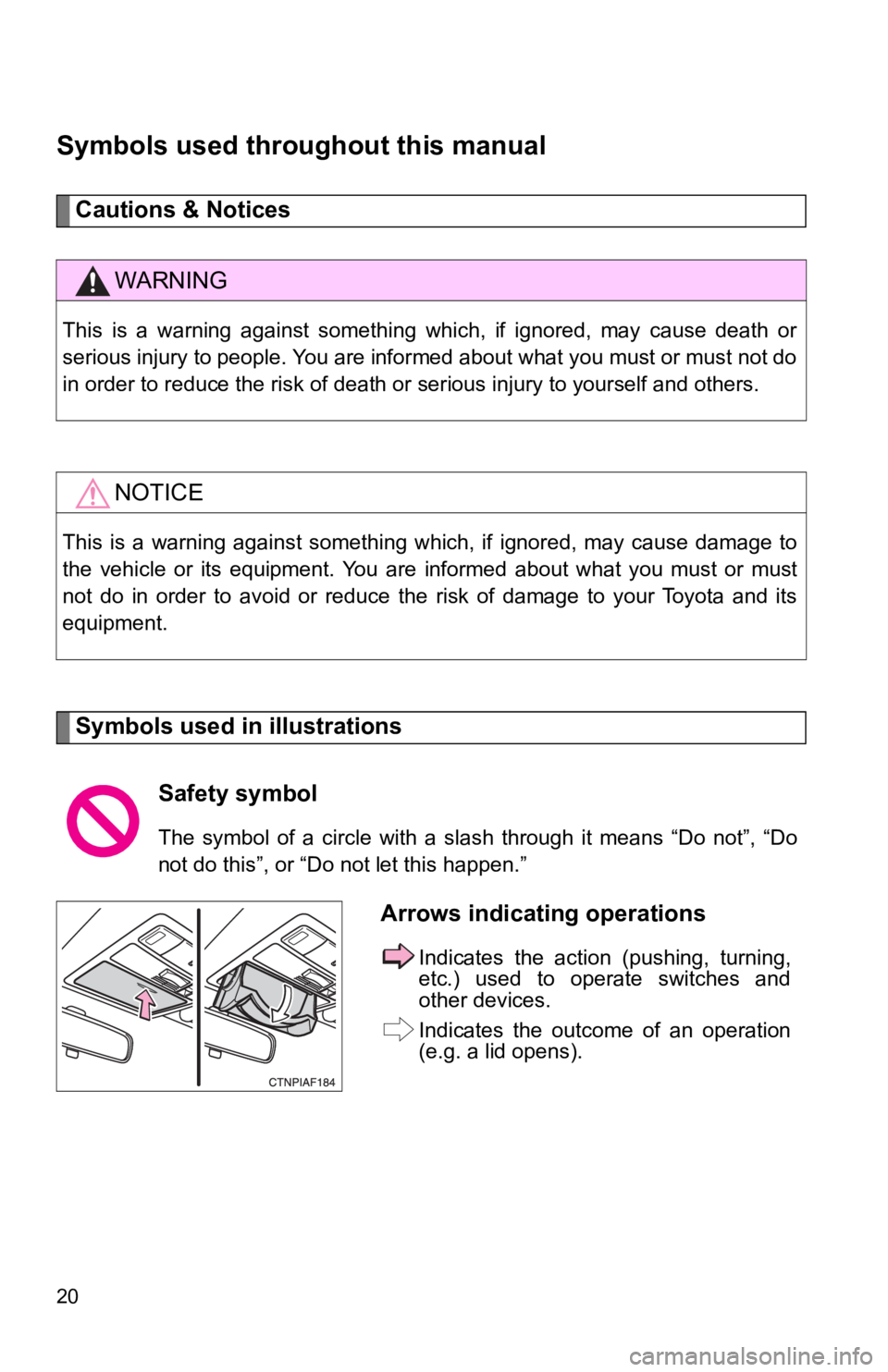
20Symbols used thro ughout this manualCautions & Notices
Symbols used in illustrations WARNINGThis is a warning against something which, if ignored, may cause death or
serious injury to people. You are informed about what you must or must not do
in order to reduce the risk of death or serious injury to yourself and others.
NOTICEThis is a warning against something which, if ignored, may cause damage to
the vehicle or its equipment. You are informed about what you must or must
not do in order to avoid or reduce the risk of damage to your Toyota and its
equipment.
Safety symbol The symbol of a circle with a slash through it means “Do not”, “Do
not do this”, or “Do not let this happen.”
Arrows indicating operations Indicates the action (pushing, turning,
etc.) used to operate switches and
other devices.
Indicates the outcome of an operation
(e.g. a lid opens).
Page 26 of 428

261-2. Opening, closing and locking the doors and trunk
■ Key battery depletion
If the wireless remote control function does not operate, the battery may be
depleted. Replace the battery when necessary. ( → P. 287)
■ When the wireless remote control battery is fully depleted
→ P. 287
■ Customization that can be conf igured at your Toyota dealer
Settings (e.g. wireless remote control system) can be changed.
(Customizable features → P. 383)
■ Certification for wireless remote control
For vehicles sold in the U.S.A.
FCC ID: HYQ23AAC FCC ID: HYQ12BEL
NOTE:
This device complies with part 15 of the FCC Rules. Operation is subject to
the following two conditions: (1) This device may not cause harmful interfer-
ence, and (2) this device must accept any interference received, including
interference that may cause undesired operation.
FCC WARNING:
Changes or modifications not expressly approved by the party responsible
for compliance could void the user's authority to operate the equipment.
For vehicles sold in Canada
NOTE:
This device complies with Industry Canada’s licence-exempt RSSs. Opera-
tion is subject to the following two conditions: (1) This device may not cause
interference; and (2) This device must accept any interference, including
interference that may cause undesired operation of the device.
NOTE:
Le présent appareil est conforme aux CNR d’Industrie Canada applicables
aux appareils radio exempts de licence. L’exploitation est autorisée aux
deux conditions suivantes: (1) l’appareil ne doit pas produire de brouillage;
(2) l’utilisateur de l’appareil doit accept er tout brouillage radioélectrique subi,
même si le brouillage est susceptible d’en compromettre le fonctionnement.
Page 29 of 428
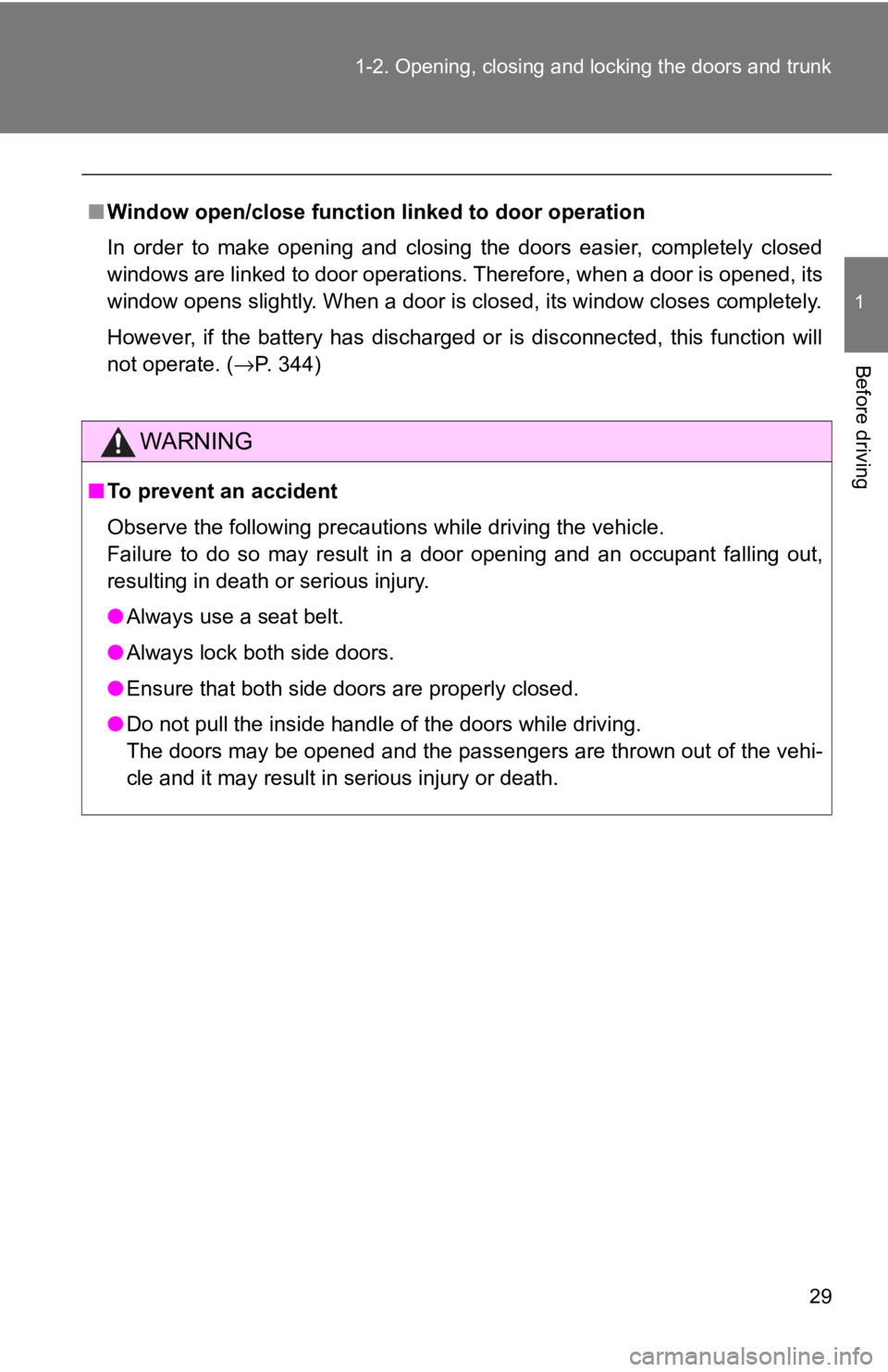
291-2. Opening, closing and locking the doors and trunk
1
Before driving ■ Window open/close function linked to door operation
In order to make opening and closing the doors easier, completely closed
windows are linked to door operations. Therefore, when a door is opened, its
window opens slightly. When a door is closed, its window closes completely.
However, if the battery has discharged or is disconnected, this function will
not operate. ( → P. 344)
WARNING■ To prevent an accident
Observe the following precautions while driving the vehicle.
Failure to do so may result in a door opening and an occupant falling out,
resulting in death or serious injury.
● Always use a seat belt.
● Always lock both side doors.
● Ensure that both side doors are properly closed.
● Do not pull the inside handle of the doors while driving.
The doors may be opened and the passengers are thrown out of the vehi-
cle and it may result in serious injury or death.
Page 32 of 428
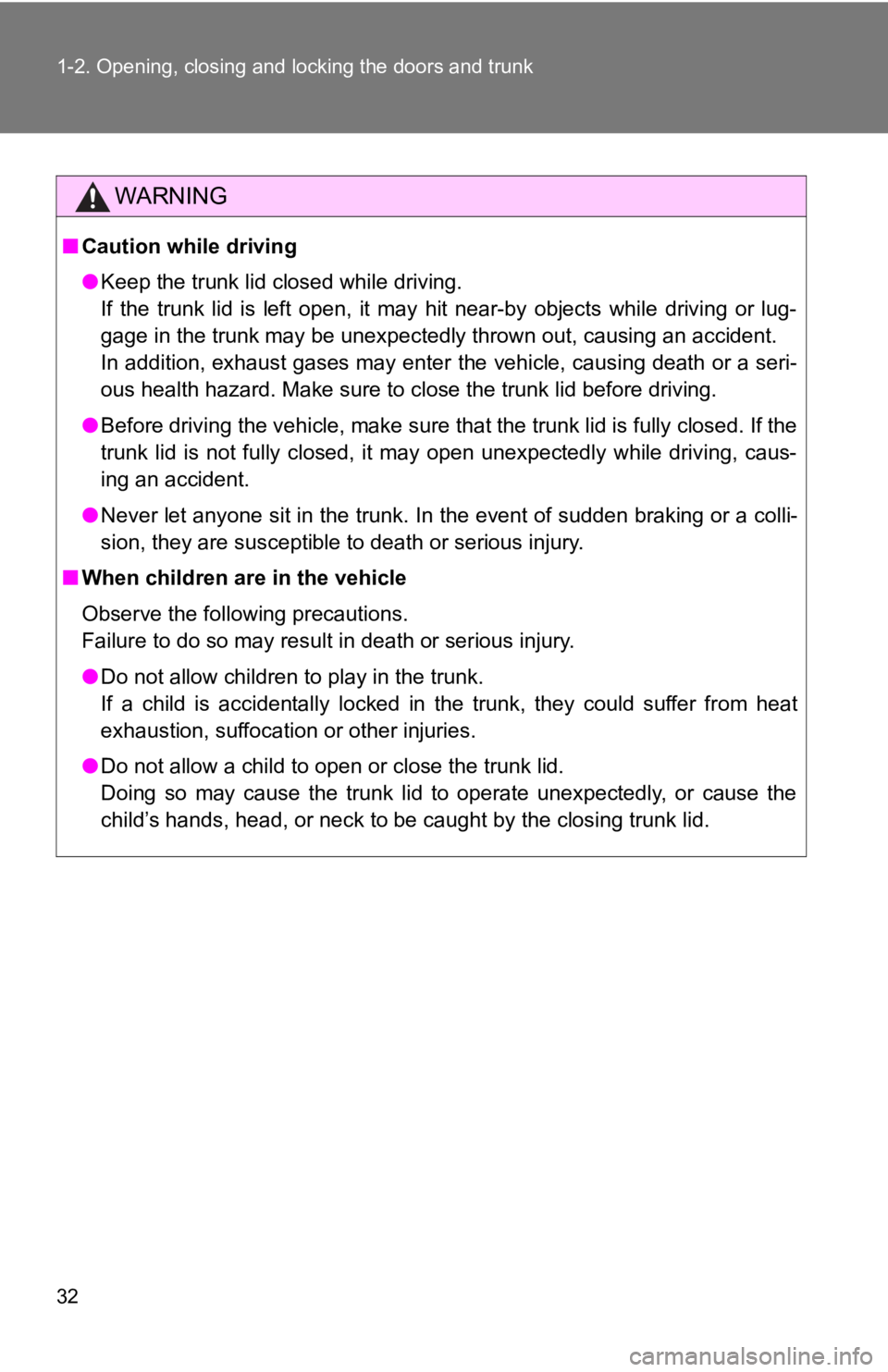
321-2. Opening, closing and locking the doors and trunk
WARNING■ Caution while driving
● Keep the trunk lid closed while driving.
If the trunk lid is left open, it may hit near-by objects while driving or lug-
gage in the trunk may be unexpectedly thrown out, causing an accident.
In addition, exhaust gases may enter the vehicle, causing death or a seri-
ous health hazard. Make sure to close the trunk lid before driving.
● Before driving the vehicle, make sure that the trunk lid is fully closed. If the
trunk lid is not fully closed, it may open unexpectedly while driving, caus-
ing an accident.
● Never let anyone sit in the trunk. In the event of sudden braking or a colli-
sion, they are susceptible to death or serious injury.
■ When children are in the vehicle
Observe the following precautions.
Failure to do so may result in death or serious injury.
● Do not allow children to play in the trunk.
If a child is accidentally locked in the trunk, they could suffer from heat
exhaustion, suffocation or other injuries.
● Do not allow a child to open or close the trunk lid.
Doing so may cause the trunk lid to operate unexpectedly, or cause the
child’s hands, head, or neck to be caught by the closing trunk lid.
Page 33 of 428
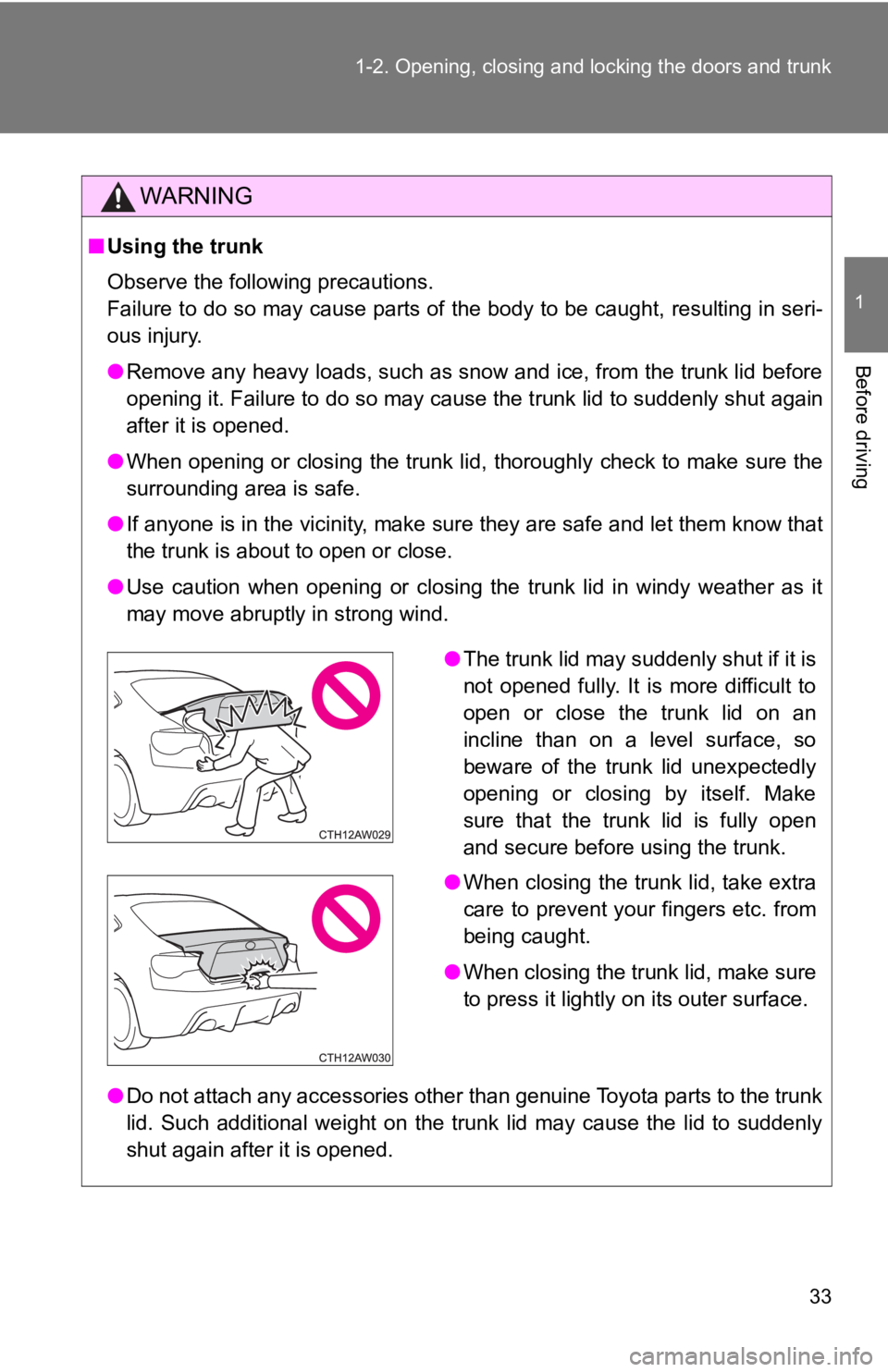
331-2. Opening, closing and locking the doors and trunk
1
Before driving WARNING■ Using the trunk
Observe the following precautions.
Failure to do so may cause parts of the body to be caught, resulting in seri-
ous injury.
● Remove any heavy loads, such as snow and ice, from the trunk lid before
opening it. Failure to do so may cause the trunk lid to suddenly shut again
after it is opened.
● When opening or closing the trunk lid, thoroughly check to make sure the
surrounding area is safe.
● If anyone is in the vicinity, make sure they are safe and let them know that
the trunk is about to open or close.
● Use caution when opening or closing the trunk lid in windy weather as it
may move abruptly in strong wind.
● Do not attach any accessories other than genuine Toyota parts to the trunk
lid. Such additional weight on the trunk lid may cause the lid to suddenly
shut again after it is opened. ● The trunk lid may suddenly shut if it is
not opened fully. It is more difficult to
open or close the trunk lid on an
incline than on a level surface, so
beware of the trunk lid unexpectedly
opening or closing by itself. Make
sure that the trunk lid is fully open
and secure before using the trunk.
● When closing the trunk lid, take extra
care to prevent your fingers etc. from
being caught.
● When closing the trunk lid, make sure
to press it lightly on its outer surface.
Page 34 of 428

341-2. Opening, closing and locking the doors and trunk
WARNING■ Trunk lid damper stays
Do not pull on or disassemble the trunk lid damper stays, or dispose of them
in a fire. Illustrations on the trunk lid damper stays indicate the following:
NOTICE■ Trunk damper stays
The trunk lid is equipped with damper stays that hold the trunk lid in place.
Observe the following precautions.
Failure to do so may cause damage to trunk damper stays, resulting in a
malfunction.
● Do not attach any foreign objects such as stickers, plastic sheets and
adhesives to damper stay rods.
● Do not touch damper stay rods with gloves or other fabric items.
● Do not attach any accessories other than genuine Toyota parts to the trunk
lid.
● Do not apply lateral force to damper stays or place your hand on it. : Do not pull
: Do not disassemble
: Do not dispose of in fire
Page 37 of 428
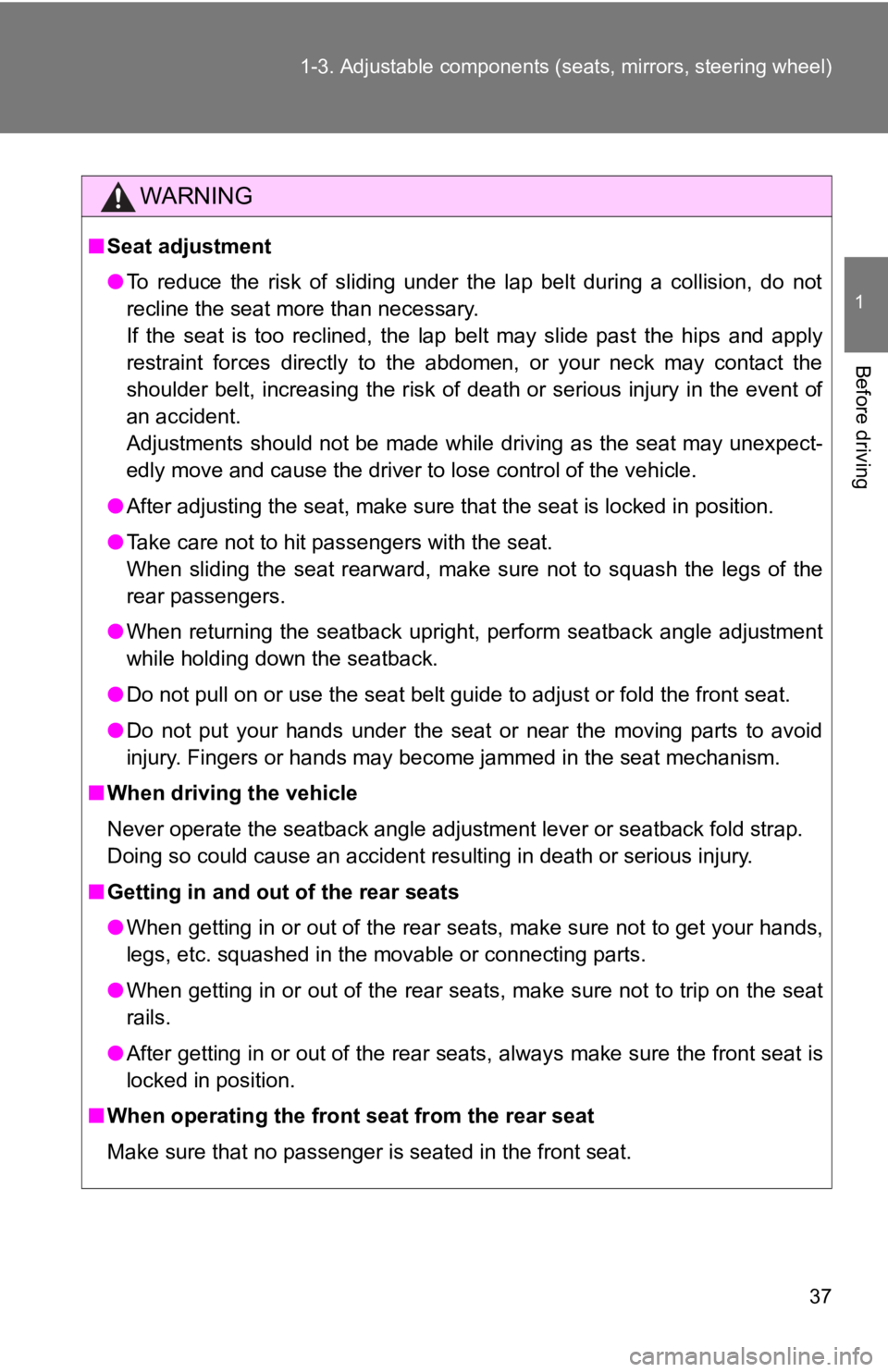
371-3. Adjustable components (s eats, mirrors, steering wheel)
1
Before driving WARNING■ Seat adjustment
● To reduce the risk of sliding under the lap belt during a collision, do not
recline the seat more than necessary.
If the seat is too reclined, the lap belt may slide past the hips and apply
restraint forces directly to the abdomen, or your neck may contact the
shoulder belt, increasing the risk of death or serious injury in the event of
an accident.
Adjustments should not be made while driving as the seat may unexpect-
edly move and cause the driver to lose control of the vehicle.
● After adjusting the seat, make sure that the seat is locked in position.
● Take care not to hit passengers with the seat.
When sliding the seat rearward, make sure not to squash the legs of the
rear passengers.
● When returning the seatback upright, perform seatback angle adjustment
while holding down the seatback.
● Do not pull on or use the seat belt guide to adjust or fold the front seat.
● Do not put your hands under the seat or near the moving parts to avoid
injury. Fingers or hands may become jammed in the seat mechanism.
■ When driving the vehicle
Never operate the seatback angle adjustment lever or seatback fold strap.
Doing so could cause an accident resulting in death or serious injury.
■ Getting in and out of the rear seats
● When getting in or out of the rear seats, make sure not to get your hands,
legs, etc. squashed in the movable or connecting parts.
● When getting in or out of the rear seats, make sure not to trip on the seat
rails.
● After getting in or out of the rear seats, always make sure the front seat is
locked in position.
■ When operating the front seat from the rear seat
Make sure that no passenger is seated in the front seat.